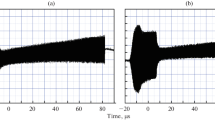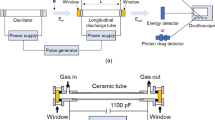Abstract
It is shown that the limiting characteristics of CO2 lasers are determined mainly by two parameters: the specific power of the electric discharge, referred to the square of the active medium pressure, and the product of the pumping time and the gas pressure. An investigation is made of the dependence of the efficiency and the radiation pulse shape over a wide range of the parameters. For the first time it is noted that the energy from the lower laser level can be given to the upper vibrational states of the symmetric and deformed modes, which allows high radiation density, ∼0.2 J/cm3 · atm, to be achieved, as is shown by calculation. Because of energy redistribution in the asymmetric mode the limiting gain coefficient in C02 lasers is ∼0.12 cm−1.
Similar content being viewed by others
Literature cited
N. G. Basov, É. M. Belenov, V. A. Danilychev, O. M. Kerimov, I. B. Kovsh, A. S. Podsosonnyi, and A. F. Suchkov, “Electroionization lasers,” Zh. Éksp. Teor. Fiz.,64, No. 1, 108 (1973).
Yu. V. Afonin, V. Byshevskii, A. G. Ponomarenko, R. I. Solukhin, and V. N. Tishchenko, “Investigation of the energy characteristics of high-power electroionization-type laser systems,” in: Proceedings of the Eleventh International Conference of Phenomena in Ionized Gases, Prague, Vol. 1 (1973), p. 166.
Yu. V. Afonin, W. Byszewski, A. G. Ponomarenko, R. I. Soloukhin, and V. N. Ticschenko, “Gain and power characteristics of an electron-beam-controlled discharge TEA CO2 laser,” Optics Comm.,10, No. 1, 11 (1974).
A. G. Ponomarenko, R. I. Solukhin, and V. N. Tishchenko, “Optimization and limiting energy characteristics of pulsed CO2 laser systems of electroionization and electric discharge type,” in: First All-Union School and Conference on the Use of Lasers in Mechanical Engineering and Other Areas of Technology and Physics of Gas Laser Development [in Russian], Nauka, Moscow (1974), p. 18.
V. Yu. Baranov, S. A. Golubev, S. S. Kingsep, I. V. Novobrantsev, V. D. Pismeny, V. P. Smirnov, A. M. Spector, A. N. Starostin, A. P. Streltsov, and E. P. Velikhov, “A study of combined discharge exciting a CO2 laser with a high-current electron beam,” in: Proceedings of the Eleventh International Conference on Phenomena in Ionized Gases, Prague, Vol. 1 (1973), p. 162.
A. M. Orishich, A. G. Ponomarenko, and R. I. Soloukhin, “Limiting energy characteristics of pulsed TEA CO2 lasers,” Zh. Prikl. Mekh. Tekh. Fiz., No. 1, 89 (1975).
W. L. Nighan, “Electron energy distributions and collision rates in electrically excited N2, CO2, and CO,” Phys. Rev. A,2, No. 5, 1989 (1970).
A. N. Lobanov and A. F. Suchkov, “Distribution functions and electron energy balance in a CO2 electroionization laser,” Kvant. Elektron.,1, No. 7, 1527 (1974).
V. F. Gordeets, N. N. Sobolev, and A. A. Shelepin, “Kinetics of the physical processes in a CO2 laser,” Zh. Éksp. Teor. Fiz.,53, 1822 (1967).
N. G. Basov, V. G. Mikhailov, A. N. Oraevskii, and V. A. Shcheglov, “Achievement of molecular population inversions in supersonic flow of a binary gas in a nozzle,” Zh. Éksp. Teor. Fiz.,38, No. 12, 2031 (1968).
A. S. Biryukov and V. F. Gordeets, “Kinetic equations for vibrational energy relaxation in a mixture of polyatomic gases,” Zh. Prikl. Mekh. Tekh. Fiz., No. 6, 29 (1969).
G. C. Vlases and W. M. Moeny, “Numerical modeling of pulsed electric CO2 lasers,” J. Appl. Phys.,43, No. 3, 1840 (1972).
S. J. Kast and C. Cason, “Performance comparison of pulsed discharge and electron-beam-controlled CO2 lasers,” J. Appl. Phys.,44, No. 4, 1631 (1973).
G. L. Schultz, “Vibrational excitation of N2, CO, and H2 by electron impact,” Phys. Rev. A,135, No. 4, 988 (1964).
Yu. V. Afonin, Yu. S. Zimin, and A. G. Ponomarenko, “A compact pulsed electroionized CO2 laser,” in: First All-Union School and Conference on Use of Lasers in Mechanical Engineering and Other Fields of Technology and Physical Processes of Gas Laser Development [in Russian], Nauka, Moscow (1974).
S. Braun, Elementary Processes in a Gas-Discharge Plasma [in Russian], Gosatomizdat, Moscow (1961).
H. Reiter, Electron Traps and Breakdown in Gases [Russian translation], Inost. Lit., Moscow (1960).
G. A. Mesyats, Yu. N. Bychkov, V. V. Kremnev, Yu. N. Korolev, Yu. A. Kurbatov, and V. K. Savin, “High-pressure CO2 laser with preionization by means of a short duration electron beam,” Preprint Inst. Optiki Atmos., Sibirsk. Otd., Akad. Nauk SSSR, No. 2 (1972).
C. A. Fenstermacher, M. J. Nutter, W. T. Lelano, and K. Boyer, “Electron-beam-controlled CO2 laser amplifiers,” Appl. Phys. Lett.,20, No. 2, 157 (1972).
C. H. H. Carmichael, R. K. Garnsworthy, and L. E. S. Mathias, “High gain at 10.6 μ from an electron-beam-controlled pulsed discharge,” Appl. Phys. Lett.,24, No. 12, 608 (1974).
N. G. Vasov, V. A. Danilychev, A. A. Ionin, I. B. Kovsh, and V. A. Sobolev, “Electroionization pulsed laser with radiation energy of 200,” Zh. Tekh. Fiz.,13, No. 11, 2357 (1973).
C. B. Moore, R. E. Wood, B. L. Hu, and J. T. Yardley, “Vibrational energy transfer in a CO2 laser,” J. Chem. Phys.,46, 4222 (1967).
A. S. Biryukov, V. K. Konyukhov, A. I. Lukovnikov, and R. I. Serikov, “Relaxation of the (0001) vibrational energy level of the CO2 molecule,” Zh. Éksp. Teor. Fiz.,66. No. 4, 1238 (1974).
W. A. Rosser, A. D. Wood, and E. T. Gerry, “Deactivation of vibrationally excited CO2 by collisions with CO2 or N2” J. Chem. Phys.,50, No. 11, 4996 (1969).
W. A. Rosser and E. T. Gerry, “Deexcitation of vibrationally excited CO2 (0001) by collisions with CO2, H2, NO2, and Cl2,” J. Chem. Phys.,54, No. 9, 4131 (1971).
C. K. Rhodes, M. J. Kelly, and A. Javan, “Collisional relaxation of the 1000 state in pure CO2,” J. Chem. Phys.,48, 5730 (1968).
E. G. Gebhardt and D. C. Smith, “Kinetic cooling of a gas by absorption of CO2 laser radiation,” Appl. Phys. Lett.,20, 129 (1972).
K. M. Merrill and R. C. Amme, “Deactivation of the CO2 bending mode by collisions with N2 and O2,” J. Chem. Phys.,51, No. 2, 844 (1969).
P. K. Cheo, “Effects of CO2, He, and N2 on the lifetimes of the 0001 and 1000 CO2 laser levels and on pulsed gain at 10.6,” J. Appl. Phys.,38, No. 9, 3563 (1967).
R. L. Taylor and S. Bitterman, “Survey of vibrational relaxation data for processes important in the CO2-N2 laser system,” Rev. Mod. Phys.,41, No. 1, 26 (1969).
Author information
Authors and Affiliations
Additional information
Translated from Zhurnal Prikladnoi Mekhaniki i Tekhnicheskoi Fiziki, No. 5, pp. 120–131, September–October, 1975.
The authors thank V. N. Vetlutskyi, A. V. Afonin, and A. M. Orishich for their help in the work.
Rights and permissions
About this article
Cite this article
Ponomarenko, A.G., Soloukhin, R.I. & Tishchenko, V.N. Optimization and limiting characteristics of CO2 lasers. J Appl Mech Tech Phys 16, 774–782 (1975). https://doi.org/10.1007/BF00854089
Received:
Issue Date:
DOI: https://doi.org/10.1007/BF00854089




